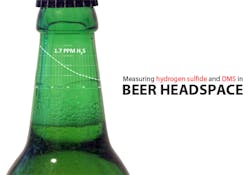Automation World Director of Content David Greenfield was telling me recently about one of his hobbies and passions: home-brewing beer. To hone his skills and test drive an alternative career some 20 years ago, he volunteered to work in a local microbrewery. One of his jobs involved washing out the interior of fermentation tanks. Because yeast consumes oxygen and expels large amounts of carbon dioxide (CO2) during the fermentation process, getting into a tank to scrub it out can be a dangerous activity. “You have to stick your head out of the tank regularly between scrubs to make sure you get enough oxygen,” he told me. “You always have to have two guys on hand, in case one passes out.”
But CO2 is also useful in the beer brewing process, aside from the obvious delights of carbonation. Prior to filling, beer bottles are purged with CO2 to remove air and protect the taste against oxidation. Considering this application of CO2, wouldn’t it make sense for the CO2 produced in the fermentation process to be reclaimed and used for this bottle-purging purpose? Apparently yes, but it’s not easy.
An application brief from Applied Analytics (AAI), a global manufacturer of industrial process analysis instruments, explains the biggest challenge: Fermentation also often produces toxic, odorous sulfides, which can foam up into the piping and contaminate the reclaimed CO2.
“In order to continue using the great resource of CO2 byproduct, yet avoid contaminating the bottled beer with foul-smelling toxins, the reclaimed gas is run through sulfide removal skids. However, sulfide breakthrough can occur if the gas does not spend enough time in the scrubber,” according to the brief.
“Employees are sometimes tasked with sniff-testing the reclaimed CO2, but this is an unhealthy practice and is too discrete to vigilantly prevent product contamination. An automatic, continuous analysis solution is required.”
In the brief, AAI engineers describe how their automated solution, the OMA Process Analyzer works to immediately divert contaminated CO2 from use in bottling, as well as to provide feedback control for the sulfur removal processing time.
The Method
The OMA Process Analyzer is used to continuously measure concentrations of hydrogen sulfide (H2S) and dimethyl sulfide (DMS) in the fermentation byproduct gas. This system uses a full-spectrum UV-Vis spectrophotometer to detect the absorbance of sulfides in the reclaimed CO2 stream—an ideal method, as CO2 has zero absorbance in the UV spectrum. The OMA provides fast-response alarms to high-concentration threshold, which allows immediate diversion of contaminated CO2.
For this application, the OMA is typically multiplexed to automatically cycle analysis between multiple sampling points. This maximizes system value by allowing one unit to monitor the raw fermentation gas entering the reclamation system, gas coming off the acid aldehyde scrubbers, and the bottling gas coming off of the sulfur removal beds—all with sample stream switching at user-defined intervals.
Using the OMA system, a brewery enables intelligent CO2 reclamation, which continuously prevents sulfide contamination of the beer product.
Applied Analytics systems are used primarily to measure real-time chemical concentrations in liquid or gas process streams, as well as physical parameters like color, calorific value and purity. AAI will be exhibiting its newest systems at two upcoming events. Look for them at the 58th ISA Analysis Division Symposium in Galveston April 14 - 18, 2013, in Galveston, Texas and at the ISA Calgary Show April 17-18, 2013 in Calgary, Alberta, Canada.
To read more about the OMA Process Analyzer and the technology used, visit AAI’s website.

